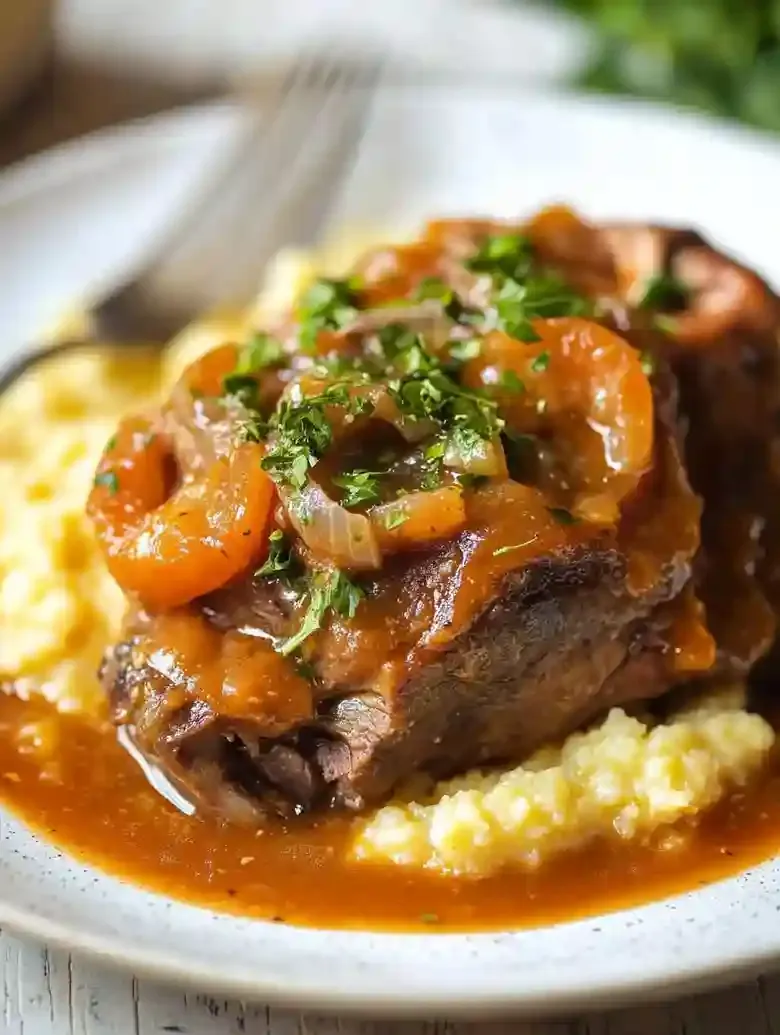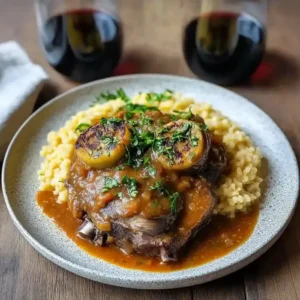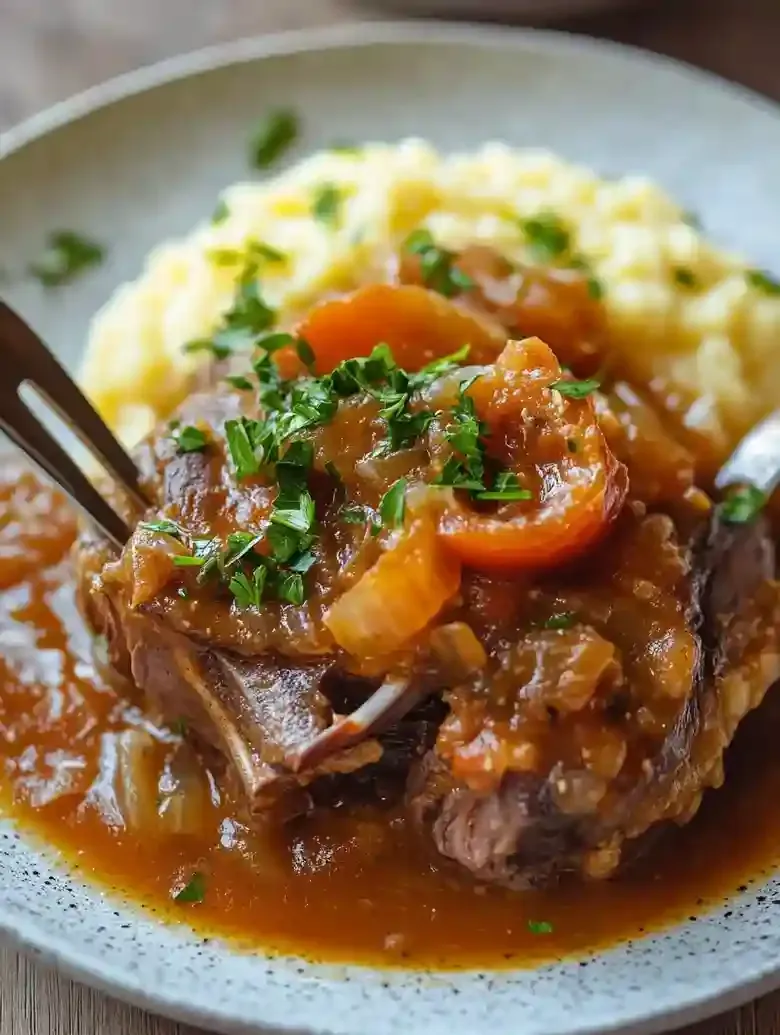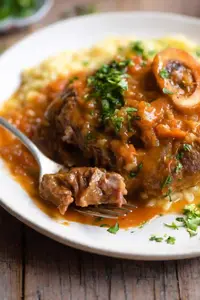If you’re curious about osso buco alla milanese, this Italian comfort dish brings tender veal shanks braised to perfection. It’s a heartfelt recipe with rich flavors, making it perfect for family dinners or cozy gatherings.
This recipe addresses challenges of tough meat, bland flavors, and inconsistent sauce thickness often faced in traditional ossobuco preparation.

I’ve faced my share of challenges while trying to perfect this dish, from overcooking the meat to unintentionally burning the garlic. But I’ve learned that patience and attention to detail are key, especially when making the delightful gremolata to finish the dish.
This recipe not only meets my expectations but also has a way of impressing everyone seated at the table in about three hours total. You can expect beautifully soft meat and an aromatic sauce that’s hard to resist, so don’t rush the process.
If you want to try something different alongside it, I recommend my broccolini frittata, which adds a fresh note to balance all that richness.
Table of contents
Dietary Considerations
- This recipe is not gluten-free due to the use of chicken stock, which may contain hidden gluten ingredients.
- The recipe contains veal shanks and white wine, so it is unsuitable for vegan and vegetarian diets.
- This recipe does not meet keto or low-carb diets because veal shanks include natural proteins with moderate fat content.
- The recipe is dairy-free and nut-free since it does not include any milk, cream, or nuts among the ingredients.
Why You Will Love This Recipe
- Savor the rich flavors This dish boasts a depth of taste from simmering veal shanks with aromatic vegetables and herbs. When you take a forkful, the combination of marrow and gremolata brings a fresh contrast that’s truly satisfying.
- Experience tender meat The slow cooking breaks down the collagen in the veal, resulting in wonderfully tender meat that practically falls off the bone. This process ensures a truly special texture with each bite.
- Make it ahead Ossobuco is an excellent choice for preparing in advance. The flavors deepen and improve when stored overnight, making the next day’s dinner a breeze while keeping the dish tasting fresh and delicious.
- Engage your senses As it simmers, the kitchen fills with enticing aromas from the garlic, wine, and herbs. The sensory experience of this dish will not only whet your appetite but also create lasting memories around the dining table.

How to Make Osso Buco Alla Milanese
- Prep Time: 10 minutes
- Cool Time:
- Cook Time: 3 hours
- Total Time: 3 hours 10 minutes
- Yield: 4 servings 1x
- Category: Main Course
- Method: Braising
- Cuisine: Italian
- Diet: Low Lactose
Description
A traditional Italian dish featuring braised veal shanks with aromatic herbs and a fresh gremolata topping.
Ingredients
- 4 bone-in veal shanks, about 1 inch (2.5 cm) thick, meaty and well-marbled
- 1–2 tbsp (15–30 ml) olive oil
- 1 carrot, finely chopped, fresh and firm
- 1 stalk celery, finely chopped, crisp and vibrant
- 1 onion, finely chopped, yellow and firm
- 2 cloves garlic, finely chopped, fresh and firm
- 3 tbsp (45 ml) tomato paste
- 2 cups (480 ml) low-sodium chicken stock
- 1 cup (240 ml) dry white wine (e.g., Pinot Grigio)
- Salt, to taste
- Pepper, to taste
- 1 bay leaf, whole and crisp
- 2 sprigs rosemary, fresh and bright green
- Gremolata, for serving (fresh parsley essential)
Instructions
- Step 1: Season the veal shanks generously with salt, pressing it into the meat so it sticks. Place flour (1–2 tbsp) on a plate. Dredge the veal shanks, coating all sides with flour, then shake off any excess.

- Step 2: Heat 1–2 tbsp olive oil over medium-high heat in a large skillet or Dutch oven until hot but not smoking. Add the veal shanks and brown on both sides, about 5 minutes per side. Browning creates a crust that locks in juices and builds flavor. Remove the veal and set aside on a plate.

- Step 3: To maintain presentation and prevent the ossobuco from falling apart during cooking, tie each piece with kitchen string. This step is optional and does not affect flavor.

- Step 4: Add more olive oil to the same pan if needed. Add the finely chopped carrot, celery, and onion. Sauté over medium heat for approximately 5–7 minutes, stirring often, until softened but not browned. This process develops the flavorful base for the sauce.

- Step 5: Pour in the white wine (1 cup). Increase heat slightly if the liquid does not reduce within 10 minutes. Simmer and let the wine reduce by half, about 5 minutes. The reduction lifts browned bits from the pan and deepens the sauce flavor.

- Step 6: Stir in 2 cups low-sodium chicken stock and 3 tbsp tomato paste, mixing well to combine into a consistent sauce.

- Step 7: Add 1 bay leaf and 2 sprigs of fresh rosemary to the pan. Return the veal shanks to the sauce. Cover the pan with a lid and set heat to low, maintaining a gentle simmer. Cook covered for 2 hours to meld flavors and tenderize the meat.

- Step 8: After 2 hours, remove the lid and simmer uncovered for an additional 30 minutes. This step thickens and intensifies the sauce. The sauce should reduce slightly and develop a richer consistency. If the sauce becomes too thick, stir in 1/4 cup hot chicken stock to adjust.

- Step 9: Serve the Ossobuco Milanese hot, topped with freshly made gremolata. The fresh herbs in gremolata add brightness and balance to the richness of the dish.

Notes
- Room Temperature: Store in an airtight container for up to 2 days, avoiding direct sunlight or heat.
- Refrigeration: Keep in an airtight container and refrigerate up to 4 days. Reheat gently on low heat to avoid drying the meat.
- Freezing: Wrap tightly in plastic wrap, place in a freezer container, and freeze for up to 3 months. Thaw overnight in the refrigerator before reheating.
- Pat veal shanks dry with paper towels before seasoning to ensure good browning.
- If wine does not reduce after 10 minutes, increase heat slightly to medium-high to speed reduction.
- To avoid overly thick sauce after simmering, add 1/4 cup hot chicken stock as needed.
- Check veal doneness after 1.5 hours; meat should be tender enough to pierce easily but not falling apart.
- If sauce tastes too salty during final simmer, balance by adding 1–2 teaspoons sugar.
- Reheat slowly over low heat to retain moisture and texture. Avoid high heat to prevent drying the veal.
- Serve Ossobuco Milanese with creamy polenta or mushroom risotto for a hearty meal. Garlic green beans or a fresh arugula salad complement the richness effectively.
- Using beef shanks instead of veal shanks can be an alternative.
- This recipe is not gluten-free due to potential gluten in chicken stock.
- Contains veal and white wine; unsuitable for vegan and vegetarian diets.
- Does not conform to keto or low-carb diets because of protein and fat profile.
- Dairy- and nut-free since no milk, cream, or nuts are used.
Nutrition
- Serving Size: 1 shank
- Calories: N/A
- Sugar: N/A
- Sodium: N/A
- Fat: N/A
- Saturated Fat: N/A
- Unsaturated Fat: N/A
- Trans Fat: N/A
- Carbohydrates: N/A
- Fiber: N/A
- Protein: N/A
- Cholesterol: N/A

Ingredient Notes
- Veal shanks: Look for meaty, well-marbled cuts from a reputable butcher. The marrow adds rich flavor and enhances the dish, so don’t skimp!
- White wine: Choose a dry white wine like Pinot Grigio. It adds acidity to balance the richness. Avoid sweet wines, which can alter the flavor profile.
- Chicken stock: Use a low-sodium chicken stock for a nuanced flavor without overpowering. Homemade works best, but store-bought is fine. Check for quality brands.
- Carrots: Fresh, firm carrots contribute sweetness and texture to the dish. Look for bright color and no blemishes for optimal flavor.
- Onions: Yellow onions work well for a mellow sweetness. Make sure they’re firm with no soft spots. They form the flavorful base of your dish.
- Celery: Fresh celery provides crunch and depth. Select stalks that’re crisp and vibrant, avoiding any that look wilted or brown.
- Garlic: Fresh garlic is a must for depth of flavor. Look for bulbs that are firm and tight-skinned. Avoid any with sprouting or soft blemishes.
- Fresh thyme: This herb adds aromatic flavors that enhance the dish. Look for bright, green sprigs. Dried thyme can substitute in a pinch, but fresh is preferred.
- Bay leaves: These are key for adding depth to the flavor. Choose whole, crisp leaves without any blemishes. Dried can work, too, just use less.
- Parsley: Fresh parsley is essential for the gremolata garnish. Find a bright green bunch without wilt. It adds freshness that brightens the dish beautifully.
Recipe Tips
- If the veal isn’t browning well, pat it dry with paper towels right before seasoning to ensure a good sear.
- When the wine hasn’t reduced after 10 minutes, increase heat slightly to medium-high until you see the liquid decrease by half.
- If the sauce thickens too much after 2 hours of simmering, stir in 1/4 cup hot chicken stock to adjust the consistency.
- For a tender texture, check the veal after 1.5 hours; it should be easy to pierce with a fork but not falling apart.
- If you notice the sauce is too salty, add 1-2 teaspoons of sugar during the final simmer to balance the flavors.
Serving Suggestions
Serve with creamy polenta or mushroom risotto for a hearty meal. Pair with garlic green beans or a fresh arugula salad.
Use to make braised veal tacos or sandwiches with crusty bread. Add to pasta dishes or a savory grain bowl for variety.
Top with gremolata for freshness. Add a drizzle of balsamic reduction for extra flavor that complements the richness.
Recipe variations
- You can use beef shanks instead of veal for ossobuco alla milanese. Season with 1 tbsp flour, salt, and pepper before browning. Either bone-in or boneless shanks work well. Double the ingredients for 8 servings.
- Add 3 tbsp tomato paste and 1 cup white wine to deepen flavor in ossobuco alla milanese. Either fresh rosemary or 1 tsp dried rosemary can be used in the braise. Increase broth proportions when doubling the recipe.
- You can use vegetable stock instead of chicken stock for a lighter sauce in ossobuco alla milanese. Either low-sodium or regular stock can be added without altering cooking times. Scale ingredients accordingly for larger groups.
- Either serve ossobuco alla milanese with gremolata or top it with lemon zest and parsley. This recipe pairs well with Parmesan linguine and garlic butter meatballs. Double portions to serve 8 people.
Save This Recipe!
How to Store?
To keep your osso buco alla milanese fresh and delicious, follow these storage tips:
Room Temperature: Store in an airtight container at room temperature up to 2 days. Keep away from direct sunlight and heat sources.
Refrigeration: Place in an airtight container and refrigerate for up to 4 days. Reheat gently over low heat to avoid drying.
Freezing: Wrap tightly in plastic wrap and place in a freezer container. Freeze up to 3 months. Thaw overnight in the refrigerator.
Other Recipes You’ll Love
- Toasted Coconut Marshmallows
- Puff Pastry Apple Rosettes
- Rhubarb and Strawberry Tart Recipe
- Chocolate Peanut Clusters
If you enjoyed this Osso Buco alla Milanese or any other recipe on my blog, please leave a ⭐ star rating and let me know how it went in the comments below. I appreciate taking time to read about this recipe, thank you!
